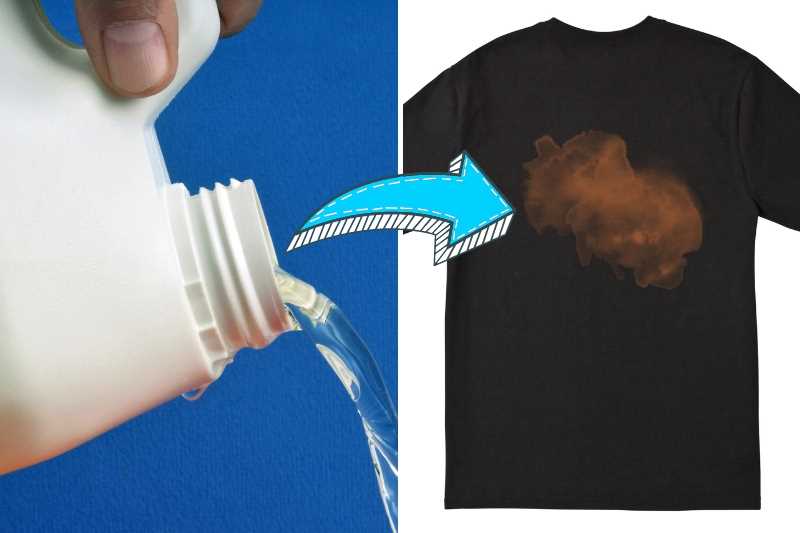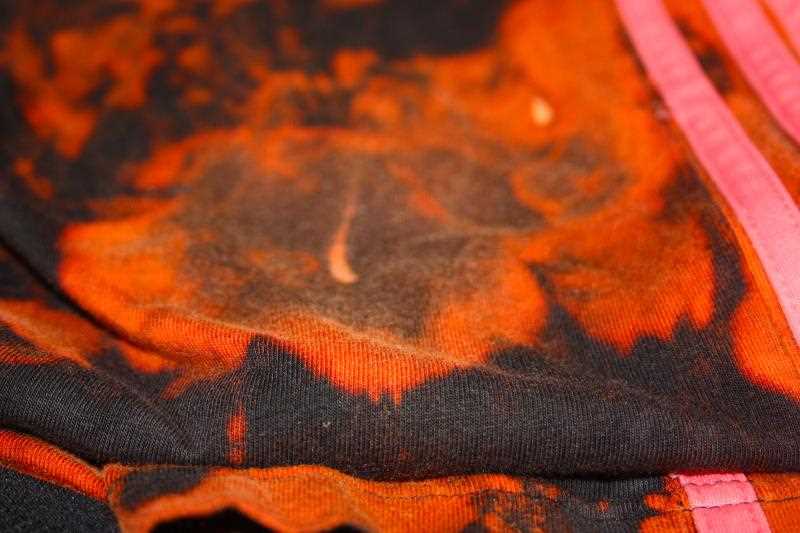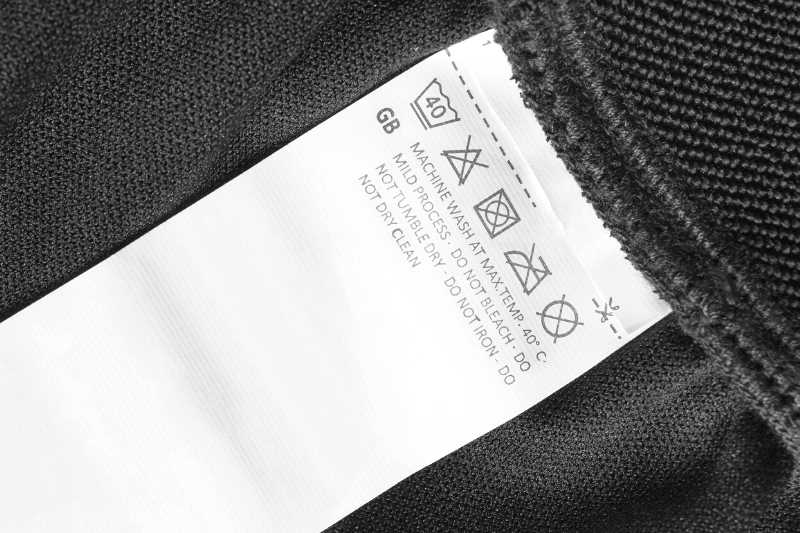


Have you ever noticed that black clothes sometimes appear to change colour to orange? This phenomenon can be quite puzzling, especially for those who have a penchant for black attire. In this article, we will explore the science behind why black clothes seem to transform into orange.
Firstly, it’s important to understand that the colour of an object is determined by the wavelengths of light that it reflects. Black is a colour that absorbs most of the light that hits it, rather than reflecting it. This is why black clothes appear to be darker than other colours, as they absorb more light. However, certain conditions can cause black clothes to take on an orange hue.
One possible explanation for this colour transformation is the presence of heat. When black clothes are exposed to high temperatures, the fabric molecules can become excited and vibrate at a faster rate. This increase in molecular activity can cause the black dye in the fabric to break down and release other pigments, such as those that create an orange colour.
Additionally, certain environmental factors, such as exposure to sunlight or certain chemicals, can also contribute to the black-to-orange transformation. Sunlight contains ultraviolet (UV) radiation, which can break down the black dye molecules in fabric over time. This can result in a change in colour, causing the black clothes to appear orange.
In conclusion, the phenomenon of black clothes changing colour to orange can be attributed to a combination of factors, including heat, environmental exposure, and the breakdown of black dye molecules. So next time you notice your black clothes taking on an orange tinge, you’ll know that there is a scientific explanation behind it!
Reasons Why Black Clothes Change Color to Orange

1. Sunlight Exposure
One of the main reasons why black clothes might change color to orange is exposure to sunlight. When black clothing is exposed to sunlight for extended periods, the ultra-violet (UV) rays from the sun can cause the fabric dyes to fade or change color. This can result in the black color appearing more orange or a reddish-brown hue.
2. Fabric Quality

The quality of the fabric used to make black clothes can also contribute to their color changing to orange. Some fabrics, especially those of lower quality, may have unstable or poorly dyed fibers. When exposed to elements like sunlight, heat, or even moisture, these fibers can undergo chemical reactions that alter the color of the fabric, often appearing as orange.
3. Dye Fading or Bleeding
In some cases, the dye used to color black clothes may not be completely colorfast, meaning it can fade or bleed when exposed to certain conditions. When this happens, the black color can change to orange as the dye molecules break down and the original color is compromised. This is more likely to occur when washing black clothes with other garments or using harsh detergents or bleaching agents.
4. Chemical Reactions

Chemical reactions, such as those caused by the use of certain cleaning products or exposure to chemicals in the environment, can also lead to black clothes changing color to orange. These reactions can alter the chemical composition of the fabric or the dye, resulting in a color shift. It is important to follow proper care instructions and avoid exposing black clothes to harsh chemicals to prevent these reactions.
5. Age and Wear
Over time, black clothing can naturally wear and fade due to regular use and washing. This can result in the black color appearing less saturated and shifting towards orange. The aging process of the fabric and repeated exposure to various elements can cause the dye to break down and lose its original color intensity.
In conclusion,

There are several reasons why black clothes may change color to orange. Sunlight exposure, poor fabric quality, dye fading or bleeding, chemical reactions, and aging and wear are all factors that can contribute to this color change. To prolong the lifespan and color vibrancy of black clothes, it is important to follow proper care instructions, minimize exposure to harsh chemicals or sunlight, and choose fabrics and dyes of good quality.
Chemical Reaction: The Science Behind it
When we observe black clothes changing colour to orange, it is the result of a fascinating chemical reaction. This reaction occurs due to the presence of certain compounds and environmental factors.
Compounds Involved

- Tannins: Black clothes are often dyed using tannins, which are complex organic compounds found in plants. Tannins provide the dark color to the fabric and offer resistance to fading.
- Oxidation Agents: The transformation of black to orange is triggered by oxidation agents. These agents are typically found in the environment or can be introduced through detergents or other chemicals.
The Reaction Process

When black clothes come in contact with an oxidation agent, a chemical reaction takes place. This reaction causes the tannins in the fabric to break down and lose their dark color, resulting in a change to the orange hue.
The oxidation agents have a powerful effect on the tannins, disrupting their molecular structure and altering their light-absorbing abilities. As a result, the fabric appears differently to our eyes, reflecting and absorbing light in a way that gives off an orange appearance.
Factors Affecting the Reaction
Several factors can influence the speed and intensity of this chemical reaction:
- The concentration and type of oxidation agent.
- The amount of tannins present in the fabric.
- The duration of exposure to the oxidation agent.
- The temperature and humidity of the environment.
These factors can vary and determine the extent to which the black clothes turn orange.
Preventing the Color Change

If you wish to prevent your black clothes from changing color to orange, consider the following tips:
- Use detergents specifically designed for black clothes, as they often contain color protectants that minimize the effects of oxidation.
- Wash black clothes separately to avoid exposure to chemicals present in other garments.
- Avoid extended exposure of black clothes to sunlight, as ultraviolet radiation can accelerate the oxidation process.
- Store black clothes in a cool, dark place to minimize exposure to environmental factors that could trigger the reaction.
In Conclusion
The change of color from black to orange in clothes is a result of a chemical reaction between the tannins in the fabric and oxidation agents present in the environment. Understanding the science behind this phenomenon can help you take measures to prevent or minimize the color change in your black garments.
Ultraviolet Radiation and its Effect on Black Fabric
Black clothes are often known to fade and change color over time, especially when exposed to sunlight. This phenomenon can be attributed to the effect of ultraviolet (UV) radiation on the fabric.
UV radiation is a type of electromagnetic radiation that comes from the sun. It has a shorter wavelength and higher energy than visible light. While UV radiation is invisible to the human eye, it can have damaging effects on various materials, including black fabric.
The Effect of UV Radiation on Black Fabric
Black fabric absorbs more UV radiation than lighter-colored fabrics. This increased absorption of UV radiation causes the fabric’s molecules to become excited and agitated. Over time, this can lead to the degradation of the fabric’s dyes and pigments.
When the dyes and pigments in black fabric break down, they can change in color and appearance. Black fabric may start to fade and appear lighter, or it may develop a different hue, such as a reddish or orangish tint. This change in color is often more noticeable in areas that are exposed to direct sunlight.
Protection Against UV Radiation
To protect black fabric from the damaging effects of UV radiation, various measures can be taken:
- Use UV-protective laundry products: Washing black clothes with laundry detergents that have UV-protective properties can help reduce the degradation of dyes and pigments.
- Avoid prolonged sun exposure: Limiting the amount of time black clothes are exposed to direct sunlight can help slow down the fading process.
- Apply fabric protectors: Using fabric protectors or UV-blocking sprays can create a barrier between the fabric and UV radiation.
- Store black clothes properly: Storing black clothes in a cool, dark place when not in use can help minimize exposure to UV radiation.
Conclusion
Black clothes can change color to orange or fade over time due to the effects of ultraviolet radiation. Understanding the impact of UV radiation on black fabric can help individuals take necessary precautions and protect their clothes from premature discoloration and fading.
Natural Wear and Tear: The Fading Process

Black clothes, like any other colored garments, are not immune to the natural wear and tear that occurs over time. This gradual fading process can be attributed to various factors, including exposure to sunlight, repeated washing, and the type of fabric used in the garment.
1. Sunlight Exposure
One of the main culprits behind the fading of black clothes is sunlight exposure. When black fabric is exposed to ultraviolet (UV) rays present in sunlight, the pigments in the fabric can break down and lose their color intensity. This process is known as photodegradation.
Over time, prolonged exposure to sunlight can cause the black fabric to appear faded and even turn into shades of orange or brown. This is because the black pigments are typically made up of a combination of colors, and when some of them break down, only the remaining pigments are visible, altering the color of the fabric.
2. Repeated Washing
Regular washing, especially with harsh detergents, can contribute to the fading of black clothes. The friction and agitation during washing can cause the fabric’s fibers to weaken, allowing the black dyes to fade or wash out gradually.
In addition, the use of hot water and excessive spinning in the washing machine can further accelerate the fading process. It is recommended to wash black clothes in cold water with gentle detergent and avoid excessive agitation to minimize fading.
3. Fabric Type
The type of fabric used in black clothes can also affect their color retention. Natural fibers, such as cotton and silk, are more prone to fading compared to synthetic fibers like polyester or nylon.
Natural fibers tend to absorb and retain dyes less effectively, causing the black color to fade more quickly. On the other hand, synthetic fibers are often dyed using more advanced techniques, resulting in better color fastness.
How to Minimize Fading
To minimize the fading of black clothes, consider the following tips:
- Turn your black clothes inside out before washing to reduce friction.
- Wash black clothes in cold water with gentle detergent specifically designed for dark colors.
- Avoid overwashing and skip unnecessary wash cycles.
- Air dry black clothes instead of tumble drying, as excessive heat can accelerate fading.
- Avoid direct sunlight exposure by hanging black clothes indoors or using clothes covers.
By following these practices, you can prolong the lifespan of your black clothes and maintain their original color for a longer period of time.
The Role of Washing and Detergents
When it comes to washing black clothes, the choice of detergent and the way you wash them can play a significant role in whether or not they change color to orange. Here are a few factors to consider:
Detergent Choice:
- Choose a detergent that is specifically formulated for dark or black clothes. These detergents often contain color-safe ingredients that help to prevent fading and color transfer.
- Avoid using bleach or harsh detergents that can strip away the color and cause fading.
Washing Temperature:
- Wash black clothes in cold water. Hot water can cause the dye in the fabric to fade or bleed, resulting in a change of color.
Washing Method:
- Turn black clothes inside out before washing. This can help to protect the outer surface and prevent color transfer.
- Use a gentle or delicate cycle when washing black clothes. Aggressive washing can cause the fabric to rub against each other, leading to color fading or bleeding.
Drying:
- Avoid drying black clothes in direct sunlight. The ultraviolet rays from the sun can cause the color to fade more quickly.
- Consider air-drying black clothes or using a low heat setting in the dryer.
Separation:
- Wash black clothes separately from lighter-colored garments, especially during the first few washes. This can prevent color bleeding and transfer.
Regular Care:
- Follow the care instructions on the garment’s label. Different fabrics may require specific washing and drying methods to maintain their color.
- Avoid over-washing black clothes, as frequent washing can lead to more rapid color fading.
By taking these factors into consideration and adopting proper washing practices, you can help to maintain the color integrity of your black clothes and prevent them from changing into orange. Remember, prevention is key when it comes to preserving the vibrant black color of your garments.
Environmental Factors: How Sunlight and Pollution Affect Color
The color change of black clothes to orange is influenced by a combination of environmental factors, including sunlight and pollution. These factors can affect the dye and fabric of black garments, leading to a change in color over time.
Sunlight
Sunlight is a major environmental factor that can impact the color of black clothes. When exposed to sunlight, the ultraviolet (UV) rays can break down the molecules in the dye, causing it to fade or change color. This is commonly referred to as photodegradation.
UV radiation is particularly damaging to black fabrics because black absorbs more light and heat. The absorption of UV rays accelerates the degradation process. Over time, prolonged exposure to sunlight can lead to the fading of black clothes and a shift towards a reddish or orange hue.
Pollution
Pollution, especially in urban areas, can also contribute to the color change of black clothes. Air pollution contains various particles and chemicals that can settle on the fabric and interact with the dye.
Particulate matter, such as soot or dust, can adhere to the fabric and alter its color. The particles can act as a catalyst for chemical reactions that change the molecular structure of the dye, resulting in a color shift. Additionally, pollutants like nitrogen dioxide and sulfur dioxide can also contribute to the degradation of the dye.
Combined Effects
The combined effects of sunlight and pollution can intensify the color change of black clothes. Sunlight can accelerate the chemical reactions caused by pollutants, leading to a more rapid deterioration of the dye and fabric.
| Environmental Factor | Effects on Color |
|---|---|
| Sunlight | Fading, shift towards orange or reddish hue |
| Pollution | Color alteration due to chemical reactions with pollutants |
| Combined Effects | Accelerated deterioration of dye and fabric |
To mitigate the color change of black clothes, it is recommended to minimize exposure to sunlight and take proper care in polluted areas. This can include storing black garments in a dark, cool place when not in use, using protective covers or clothing storage bags, and washing clothes according to the manufacturer’s instructions, using mild detergents and avoiding excessive heat.
Understanding the effects of environmental factors on the color of black clothes can help individuals prolong the lifespan and vibrancy of their garments.
FAQ
Why do black clothes change colour to orange?
Black clothes change colour to orange due to a phenomenon called fading. The black dye used in clothing is not as stable as other colours, so it is more prone to fading over time. When black clothes are exposed to sunlight, heat, and washing, the dye molecules break down and can gradually change colour, often turning a shade of orange.
Is it only black clothes that change colour to orange?
No, other dark colours can also fade and change colour over time. However, black clothes are more noticeable because the change is from a dark colour to a lighter and different shade, like orange. Other dark colours may fade and change to a slightly lighter shade of the same colour.
Can anything be done to prevent black clothes from changing colour to orange?
There are a few steps you can take to minimize colour fading in black clothes. Firstly, avoid exposing them to direct sunlight for extended periods of time. It is also recommended to wash them in cold water using a gentle cycle, as hot water and harsh detergents can cause more colour loss. Additionally, you can turn black clothes inside out before washing to reduce friction and fading. Finally, line drying instead of using a dryer can also help preserve the colour of black clothes.
Does the quality of the dye used in black clothes affect how quickly they change colour to orange?
Yes, the quality of the dye used in black clothes can have an impact on how quickly they fade and change colour. Higher quality dyes are typically more stable and will last longer without significant fading. Cheaper or lower quality dyes may break down more readily, causing the colour to change more quickly. It is worth investing in higher quality black clothing if you want it to maintain its true colour for a longer period of time.
Is there a way to restore the original black colour of clothes that have changed to orange?
Unfortunately, once black clothes have faded and changed to an orange colour, it is difficult to fully restore them to their original black shade. However, there are dye products available that allow you to dye clothing at home, including black dyes specifically designed for fabrics. Using one of these dyes may help darken the orange colour and bring it closer to black again, but the results may vary depending on the fabric and fading of the clothing.
Why do black clothes change colour to orange?
Black clothes can sometimes appear to change colour to orange under certain lighting conditions. This phenomenon is known as metamerism. It occurs because different light sources emit different wavelengths of light, and our eyes perceive color based on these wavelengths. Black objects absorb most of the light that hits them, but under certain lighting conditions, the light that is reflected back may have a slightly orange tint, causing the clothes to appear orange rather than black.
How does metamerism cause black clothes to appear orange?
Metamerism is a phenomena that occurs when an object appears to change color depending on the lighting conditions. In the case of black clothes appearing orange, it happens because different light sources emit different wavelengths of light. Black objects absorb most of the light that hits them, but under certain lighting conditions, the light that is reflected back may have a slightly orange tint. This causes our eyes to perceive the clothes as being a different color, even though they are still technically black.











